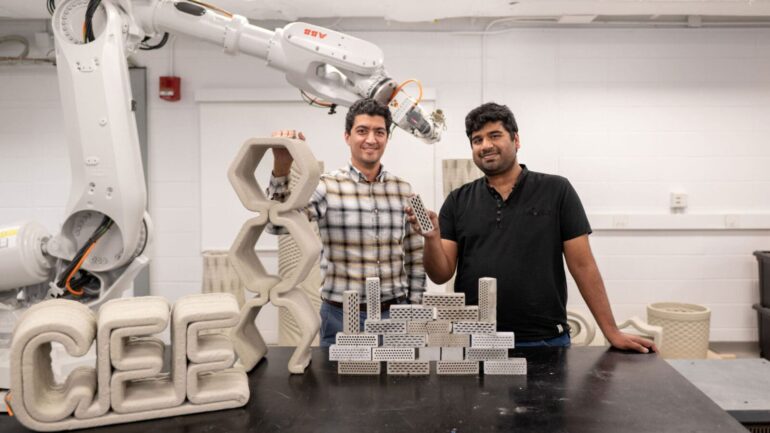Inspired by the architecture of human bone’s tough outer layer, engineers at Princeton have developed a cement-based material that is 5.6 times more damage-resistant than standard counterparts. The bio-inspired design allows the material to resist cracking and avoid sudden failure, unlike conventional, brittle cement-based counterparts.
In a new article in the journal Advanced Materials, the research team led by Reza Moini, an assistant professor of civil and environmental engineering, and Shashank Gupta, a third-year Ph.D. candidate, demonstrates that cement paste deployed with a tube-like architecture can significantly increase resistance to crack propagation and improve the ability to deform without sudden failure.
“One of the challenges in engineering brittle construction materials is that they fail in an abrupt, catastrophic fashion,” Gupta said.
In brittle construction materials used in building and civil infrastructure, strength ensures the ability to sustain loads, while toughness supports resistance to cracking and spread of damage in the structure. The proposed technique tackles those problems by creating a material that is tougher than conventional counterparts while maintaining strength.
Moini said the key to the improvement lies in the purposeful design of internal architecture, by balancing the stresses at the crack front with the overall mechanical response.
“We use theoretical principles of fracture mechanics and statistical mechanics to improve materials’ fundamental properties ‘by design,'” he said.
The team was inspired by human cortical bone, the dense outer shell of human femurs that provides strength and resists fracture. Cortical bone consists of elliptical tubular components known as osteons, embedded weakly in an organic matrix. This unique architecture deflects cracks around osteons. This prevents abrupt failure and increases overall resistance to crack propagation, Gupta said.
The team’s bio-inspired design incorporates cylindrical and elliptical tubes within the cement paste that interact with propagating cracks.
“One expects the material to become less resistant to cracking when hollow tubes are incorporated,” Moini said. “We learned that by taking advantage of the tube geometry, size, shape, and orientation, we can promote crack-tube interaction to enhance one property without sacrificing another.”
The team discovered that such enhanced crack-tube interaction initiates a stepwise toughening mechanism, where the crack is first trapped by the tube and then delayed from propagation, leading to additional energy dissipation at each interaction and step.
“What makes this stepwise mechanism unique is that each crack extension is controlled, preventing sudden, catastrophic failure,” said Gupta. “Instead of breaking all at once, the material withstands progressive damage, making it much tougher.”
Unlike traditional methods that strengthen cement-based materials by adding fibers or plastics, the Princeton team’s approach relies on geometric design. By manipulating the structure of the material itself, they achieve significant improvements in toughness without the need for additional material.
In addition to improving fracture toughness, the researchers introduced a new method to quantify the degree of disorder, an important quantity for design. Based on statistical mechanics, the team introduced parameters to quantify the degree of disorder in architected materials. This allowed the researchers to create a numerical framework reflecting the degree of disorder of the architecture.
The researchers said the new framework provides a more accurate representation of the material’s arrangements, moving towards a spectrum from ordered to random, beyond the simple binary classifications of periodic and non-periodic. Moini said that the study makes a distinction between approaches that confuse irregularity and perturbation with statistical disorders such as Voronoi tessellation and perturbation methods.
“This approach gives us a powerful tool to describe and design materials with a tailored degree of disorder,” Moini said. “Using advanced fabrication methods such as additive manufacturing can further promote the design of more disordered and mechanically favorable structures and allow for scaling up of these tubular designs for civil infrastructure components with concrete.”
The research team has also recently developed techniques allowing for a great deal of precision using robotics and additive manufacturing. By applying them to new architectures, and combinations of hard or soft materials within the tubes, they hope to expand the possibilities of applications in construction materials.
“We’ve only begun to explore the possibilities,” Gupta said. “There are many variables to investigate, such as applying the degree of disorder to the size, shape, and orientation of the tubes in the material. These principles could be applied to other brittle materials to engineer more damage-resistant structures.”
More information:
Shashank Gupta et al, Tough Cortical Bone‐Inspired Tubular Architected Cement‐Based Material with Disorder, Advanced Materials (2024). DOI: 10.1002/adma.202313904
Provided by
Princeton University
Citation:
Team develops tougher concrete, inspired by bone (2024, September 16)



